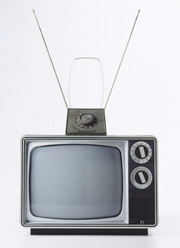Television: Difference between revisions
imported>Russell Potter mNo edit summary |
imported>Russell Potter No edit summary |
||
| Line 1: | Line 1: | ||
[[Image:Television.JPG|right|thumb|A 1970's-era television receiver, with "rabbit ears" antennae for receiving | [[Image:Television.JPG|right|thumb|A 1970's-era television receiver, with "rabbit ears" antennae for receiving VHF transmissions, and a loop for UHF signals]] | ||
'''Television''' (also, informally, "TV" and "telly") is the electronic transmission of moving pictures. Most television signals also include synchronized sound, an exception being surveillance cameras, which usually have no audio. | '''Television''' (also, informally, "TV" and "telly") is the electronic transmission of moving pictures. Most television signals also include synchronized sound, an exception being surveillance cameras, which usually have no audio. | ||
Revision as of 14:13, 15 June 2007
Television (also, informally, "TV" and "telly") is the electronic transmission of moving pictures. Most television signals also include synchronized sound, an exception being surveillance cameras, which usually have no audio.
"Television" literally means "far sight". The word was formed by combining the Greek word τῆλε ("tele", or "far") with the Latin word visio-n ("sight", from video, vis- to see) — this coinage follows the pattern of telegraph ("far writer") and telephone ("far talker"). In general usage, the meaning of "television" has been expanded to also refer to receivers, and to both the video broadcasting industry and its programming.
Broadcasting development
(for the main entry, see History of television)
In Britain, John Logie Baird demonstrated the first practical television on 26 January 1926 at his laboratory in London, and built a complete experimental broadcast system around his technology. The BBC transmitted regular broadcasts using Baird's 30-line mechanical-electronic system from 1930 through 1934. Work toward a higher-definition system developed along parallel lines, with Baird's eventually switching to a hybrid 240-line mechanical-electronic system, which employed scanned film as an intermediate step, while EMI-Marconi offered its 405-line "System A", which used Vladimir Zworykin's all-electronic setup. Beginning in November of 1936,the BBC alternated between the Baird and EMI systems, but the Baird system tests were ended after four months. The start of the Second World War resulted in the suspension of the BBC service beginning September 1, 1939, and it was not resumed until June 7, 1946.
In the United States, various mechanical systems were employed in the early years, but none achieved an effective standard as had Baird's in the United Kingdom. Electronic television systems relied on the inventions of Philo T. Farnsworth, Vladimir Zworykin and others to produce a system suitable for mass distribution of television programming. Farnsworth gave the world's first public demonstration of an all-electronic television system at the Franklin Institute in Philadelphia on 25 August 1934. All modern analog television systems derive directly from Farnsworth's model.
RCA, using Zworykin's patents, achieved some success, but was eventually forced in court to license the Farnsworth patents as they contained elements of "prior art." These patents, however, expired not long after broadcasts recommenced in the United States in 1945, and RCA soon dominated the market. Unlike the system in the UK, which relied upon licensing fees for receiving sets, Television in the US depended, as had radio before it, on corporate sponsorship via advertising, with the result that broadcast neworks, such as CBS, NBC, and latger ABC, dominated programmming in "prime time," with local affiliates supplying a percentage of locally-sponsored and originated material in individual markets.
